Datasets

SCI Head Model
The data repository includes high-resolution T1 and T2-weighted magnetic resonance images (MRI), diffusion-weighted images (DWI), functional MRIs (fMRI), and electroencephalogram recordings.
Learn More

EDGAR
Experimental Data and Geometric Analysis Repository, or EDGAR is an Internet-based archive of curated data that are freely distributed to the international research community for the application and validation of electrocardiographic imaging (ECGI) techniques.
Learn More
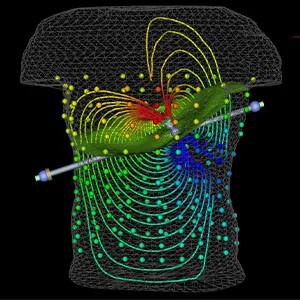
Archived Datasets
These are archived datasets that are not actively maintained beyond 2018.
Learn More
Scientific Software Environments
Software at the SCI Institute is developed in close collaboration with application users to satisfy real needs within their research communities. We use a robust, yet agile software process that is fully open-source to produce software environments that integrate leading-edge algorithms in image processing, scientific visualization, and scientific computing. Software products developed at the SCI Institute can be categorized in the following ways: Problem Solving Environments (Integrated Modeling, Simulation, and Visualization), Image Analysis, Geometric and Shape Modeling, Simulation, and Visualization.
CIBC Software Suite
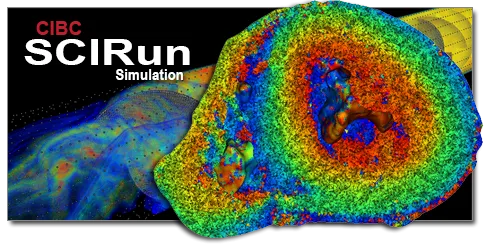
SCIRun
SCIRun is a problem solving environment or “computational workbench” in which a user selects software modules that can be connected in a visual programing environment to create a high level workflow for experimentation. Each module exposes all the available parameters necessary for scientists to adjust the outcome of their simulation or visualization. The networks in SCIRun are flexible enough to enable duplication of networks and creation of new modules,.
More information and downloads
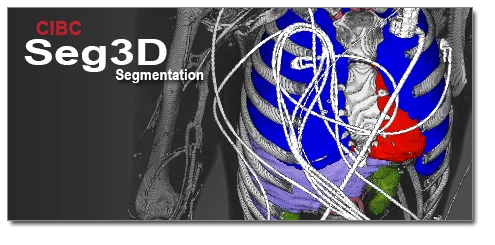
Seg3D
Seg3D is a free volume segmentation and processing tool developed by the NIH Center for Integrative Biomedical Computing at the University of Utah Scientific Computing and Imaging (SCI) Institute. Seg3D combines a flexible manual segmentation interface with powerful higher-dimensional image processing and segmentation algorithms from the Insight Toolkit. Users can explore and label image volumes using volume rendering and orthogonal slice view windows.
More information and downloads
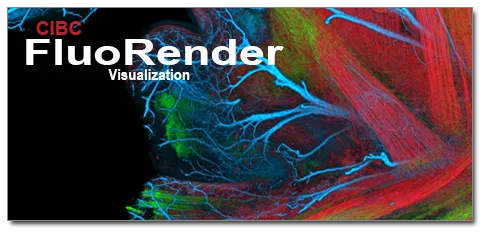
FluoRender
FluoRender is an interactive rendering tool for confocal microscopy data visualization. It combines the rendering of multi-channel volume data and polygon mesh data, where the properties of each dataset can be adjusted independently and quickly. The tool is designed especially for neurobiologists, allowing them to better visualize confocal data from fluorescently-stained brains, but it is also useful for other biological samples.
More information and downloads
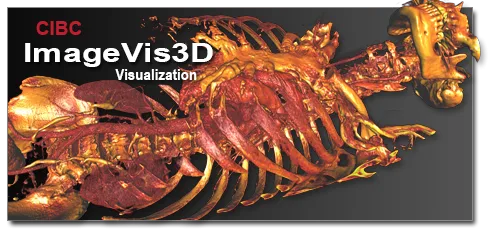
ImageVis3D
The main design goals of the ImageVis3D volume rendering program are: simplicity, scalability, and interactivity. Simplicity is achieved with a user interface that gives an unprecedented level of flexibility. Scalability and interactivity, mean that users can interactively explore terabyte-sized data sets on hardware ranging from mobile devices to high-end graphics workstations. Finally, the open source nature as well as the strict component-by-component design allow developers not only to extend ImageVis3D itself but also reuse parts of it, such as the rendering core.
More information and downloads
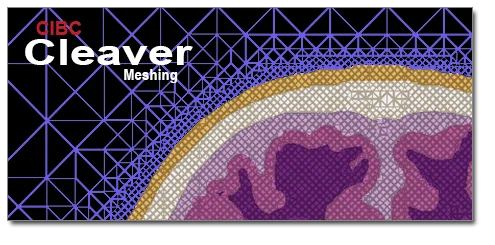
Cleaver
Cleaver is a multi material tetrahedral meshing API and application. Cleaver generates conforming tetrahedral meshes for multimaterial or multiphase volumetric data. Both geometric accuracy and element quality are bounded. The method is a stencil-based approach, and relies on an octree structure to provide a coarse level of grading in regions of homogeneity.
More information and downloads
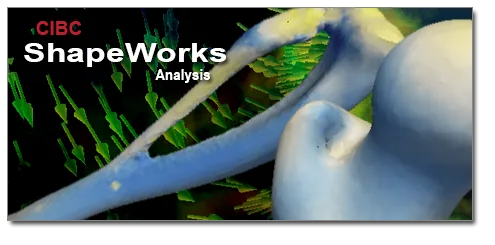
Shapeworks
The ShapeWorks software is an open-source distribution of a new method for constructing compact statistical point-based models of ensembles of similar shapes that does not rely on any specific surface parameterization. The method requires very little preprocessing or parameter tuning, and is applicable to a wide range of shape analysis problems, including nonmanifold surfaces and objects of arbitrary topology. The ShapeWorks software includes tools for preprocessing data, computing point-based shape models, and visualizing the results.
More information and downloads
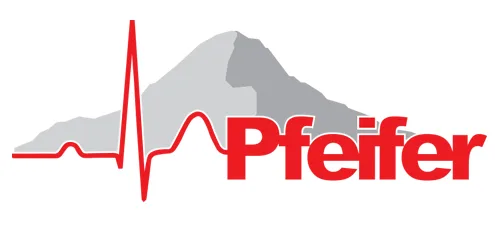
Pfeifer
Preprocessing Framework for Electrograms Intermittently Fiducialized from Experimental Recordings (PFEIFER) is a MATLAB Graphical User Interface designed to process bioelectric signals acquired from experiments. PFEIFER was specifically designed to process electrocardiographic recordings from electrodes placed on or around the heart or on the body surface.
More information and downloads
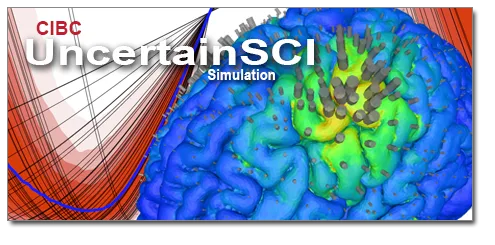
UncertainSCI
UncertainSCI is a Python-based toolkit that harnesses modern techniques to estimate model and parametric uncertainty, with a particular emphasis on needs for biomedical simulations and applications. This toolkit enables non-intrusive integration of these techniques with well-established biomedical simulation software.
More information and downloads
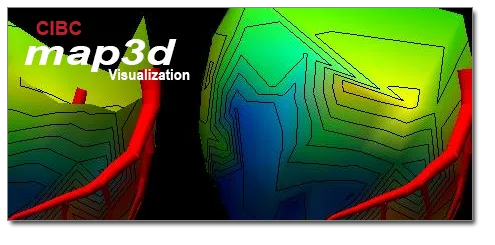
map3d
Map3d is a scientific visualization application developed at the CVRTI to display and edit complex, three-dimensional geometric models and the scalar data associated with those models. The map3d interface provides interactive display of both geometry and data assigned to elements of that geometry. The program can read multiple surfaces, each with multiple associated potential/current data files.
More information and downloads
More SCI Software
FEBio
FEBio is a nonlinear finite element solver that is specifically designed for biomechanical applications. It offers modeling scenarios, constitutive models and boundary conditions that are relevant to many research areas in biomechanics. All features can be used together seamlessly, giving the user a powerful tool for solving 3D problems in computational biomechanics. The software is open-source, and pre-compiled executables for Windows, Mac OS X and Linux platforms are available.
More information and downloads
Uintah
The Uintah software suite is a set of libraries and applications for simulating and analyzing complex chemical and physical reactions. These reactions are modeled by solving partial differential equations on structured adaptive grids using hundreds to thousands of processors (though smaller simulations may also be run on a scientist’s desktop computer). Key software applications have been developed for exploring the fine details of metal containers (encompassing energetic materials) embedded in large hydrocarbon fires. Uintah’s underlying technologies have led to novel techniques for understanding large pool eddy fires as well as new methods for simulating fluid-structure interactions. The software is general purpose in nature and the breadth of simulation domains continues to grow beyond the original focus of the C-SAFE initiative.
More information and downloads
R-Pulsar
R-Pulsar is an IoT Edge Framework, that extends cloud capabilities to local devices and provides a programming model for deciding what, when, and where data get collected and processed. It has been deployed and tested on embedded devices (Raspberry Pi and Android phone) and presents an experimental evaluation that demonstrates that R-Pulsar can enable timely stream analytics by effectively leveraging edge and core resources.
More information and downloads
DataSpaces
DataSpaces is a programming system targeted at current large-scale systems and designed to support dynamic interaction and coordination patterns between scientific applications. DataSpaces essentially provides a semantically specialized shared-space abstraction using a set of staging nodes. This abstraction derives from the tuple-space model and can be associatively accessed by the interacting applications of a simulation workflow. DataSpaces also provides services including distributed in-memory associative object store, scalable messaging, as well as runtime mapping and scheduling of online data analysis operations.
More information and downloads
CometCloud
The overarching goal of CometCloud is to realize virtual computational cloud infrastructure that integrates local computational environments and public cloud services on-demand, and provide abstractions and mechanisms to support a range of programming paradigms and real-world applications on such an infrastructure. Specifically, CometCloud provides programming abstractions and underlying mechanisms and services. Furthermore, it enables policy-based autonomic cloud-bridging and cloud-bursting. Autonomic cloud-bridging enables on-the-fly integration of local computational environments (data-centers, grids) and public cloud services (such as Amazon EC2), and autonomic cloud-bursting enables dynamic application scale-out to address dynamic workloads, spikes in demands, and other extreme requirements.
More information and downloads
PIDX
The IDX data format provides efficient, cache oblivious, and progressive access to large-scale scientific datasets by storing the data in a hierarchical Z (HZ) order. Data stored in IDX format can be visualized in an interactive environment allowing for meaningful explorations with minimal resources. With PIDX it is now possible to generate IDX datasets directly from large scale scientific simulations with the added advantage of real-time monitoring and visualization of the generated data.
More information and downloads
Nektar++
Nektar++ is an open-source software framework designed to support the development of high-performance scalable solvers for partial differential equations (and in particular conservation laws) using the spectral/hp element method. The software supports a variety of discretisation techniques and implementation strategies, supporting methods research as well as application-focused computation, and the multi-layered structure of the framework allows the user to embrace as much or as little of the complexity as they need. The libraries capture the mathematical constructs of spectral/hp element methods, while the associated collection of pre-written PDE solvers provides out-of-the-box application-level functionality and a template for users who wish to develop solutions for addressing questions in their own scientific domains.
More information and downloads
